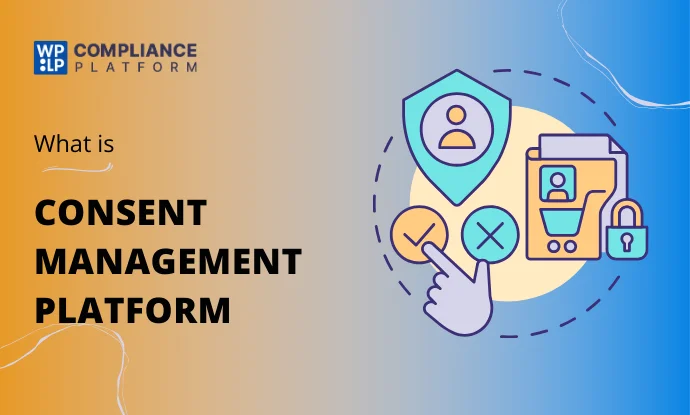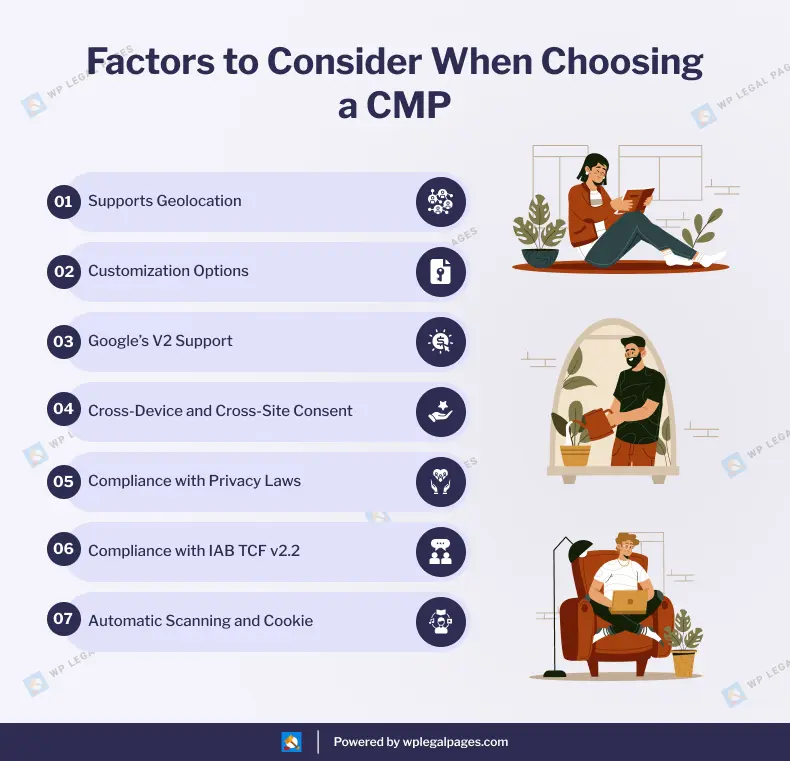Consent Management Platform (CMP) – A Guide For Compliance

Summary
Our article explains how a CMP works, its key features, and why it’s essential. It also offers tips on choosing the right platform for compliance and a better user experience.
Are you aware of what the consent management platform is?
A consent management platform (CMP) is a tool or plugin that helps protect and manage users’ data securely. Before placing cookies on the user’s device, a CMP helps to obtain user consent for collecting their personal data.
As data usage has grown enormously over the years, laws and regulations have been formed to protect individuals’ data, including GDPR, CCPA, eprivacy directives, and many more.
As collecting information through cookies has raised many concerns among users. They have the right to know how their data is being used.
In this article, we will discuss the significance of the consent management platform and how to implement it on your website.
What is a Consent Management Platform (CMP)?
Consent management platforms are tools that give users of your website the freedom to decide what data they wish to share with you.
Websites that need user consent to process their personal data can gather and maintain consent using a cookie consent manager. In short, CMPs make consent gathering simpler and more transparent.
CMP has become crucial for websites and apps that use cookies and other trackers to gather data. Data privacy rules mandate that websites and applications obtain users’ agreement before collecting data from them.
The majority of privacy rules require websites to obtain consent from users, track that consent, and use it responsibly. Additionally, it explains to visitors how and why your information is collected and how it is used.
If your website doesn’t have a consent management solution, you could face financial consequences for violating data protection regulations, particularly for the following laws: GDPR, the ePrivacy Directive, and the CCPA.
Why Should You Use a Consent Management Platform
Consent management platform use has a number of significant advantages, such as:
- Compliance with Data Protection Regulations: Consent management systems assist businesses in adhering to data protection laws, including the California Consumer Privacy Act (CCPA) and the General Data Protection Regulation (GDPR). These platforms guarantee that businesses acquire and handle user consent in an open, law-abiding, and transparent manner.
- Enhanced User Trust: Consent management platforms contribute to the development and upkeep of user trust by giving users authority over data collection, usage, and transparency. This may increase client happiness and loyalty.
- Risk Mitigation: Implementing a consent management platform can reduce the danger of breaking data protection rules. This might decrease the possibility of penalties, legal action, and harm to one’s reputation resulting from non-compliance.
- Customized User Experience: Consent management systems enable businesses to adjust how they gather and use user data according to user preferences. This may result in more relevant and tailored user experiences, which raise customer happiness and engagement levels.
- Data Transparency: By enabling businesses to be more open and honest about their data practices, these platforms help build confidence and show that they care about their users’ privacy. This openness can enhance the reputation of a brand.
Companies that respect customer trust, compliance, risk reduction, customized user experiences, and open data practices must employ a consent management platform.
Factors To Look For When Choosing a Consent Management Platform
While choosing the right consent management platform for your organization, you must consider the following factors:

1. GeoLocation Settings
- Customize user experiences based on where they are.
- Adjust policies to meet different location’s rules.
- Control data collection based on where users are.
2. Banner Customization
- Make the banners on your site match different brands.
- Use tools to design banners or customize them with specific styles.
- Choose options that are easy to use or need more technical skills.
3. Consent Behavior and Implementation
- New ways are used to collect data based on user consent.
- Check how the platform is added to your site and how it works with data collection.
- Make sure it can track page views and specific events for better data collection.
4. Global Privacy Control Support
- Look for support to manage consent choices automatically.
- Ensure you follow the rules, such as GPC, to avoid fines.
- Choose a platform that can automatically handle consent based on GPC.
5. Google Consent Mode Support
- Choose a platform that works with Google Consent Mode.
- It should be able to tell Google about the latest user consent choices.
- You should be able to turn on or off Google Consent Mode support.
6. Cross-Device & Cross-Site
- Find support to remember consent choices on different devices.
- The platform should remember user consent across different brand sites.
- Make sure it meets regulations and can work across different systems.
7. Vendor Support and Resources
- Check what help and resources are available to implement the platform.
- Ask about the support provided by the vendor.
- Look for features to make things easier for large organizations, like bulk editing and API support.
8. Compliance With Privacy Laws
- Check if the plugin complies with all the privacy laws around the world.
- Look at the plugin Transparent Consent Management and comprehensive documentation and reporting to demonstrate compliance with regulations.
- Cross-check if they provide regular updates to their plugin according to the changes made to the privacy laws.
9. Supports IAB TCF v2.2 Compliance
- Check if it provides Seamless integration with IAB TCF v2.2.
- Ask if the plugin provides granular consent controls and supports easy vendor list management in line with the framework.
- Check if it efficiently handles third-party vendor participation and consent in compliance with industry standards.
10. Automatic Scanning and Cookie Detection
- Prioritize a CMP that offers automatic real-time scanning of websites to identify and categorize cookies.
- Choose a CMP that provides customizable and user-friendly cookie consent banners, which can automatically detect and communicate the use of cookies to visitors.
- In addition, also check if it includes features for automatic cookie detection, categorization, and management, supporting ongoing compliance.
11. Data Security
- Ensure that it prioritizes data security through robust encryption and anonymization techniques.
- Look for audit Trails and Access Controls in the plugin for advanced data security.
- Prioritize a CMP that aligns with industry best practices and standards for data security, such as ISO 27001, to ensure the highest level of protection for user information and consent data.
Assessing these aspects thoroughly before choosing any CMP is essential to guaranteeing an effortless integration process and continuous operational success.
How Does a Consent Management Platform (CMP) Work?
Although an efficient CMP facilitates an organization’s regulatory compliance, it’s critical to recognize that various businesses use different approaches and, thus, have varying perspectives regarding consent. The majority of firms will, therefore, have different needs from those of others in the market in terms of their CMP.
Because of this, numerous CMP tool options are available in the market to address businesses’ diverse, particular, and frequently special demands. The different solutions vary in usability, cost, features, and general support.
Still, the majority of CMP solutions will probably function similarly. This includes:
- Consent: This is the second and most crucial justification for using a CMP. Every user who visits is shown a consent banner explaining the data processing operations and requesting consent.
- Integration: The initial phase involves suitably incorporating the CMP solution into a company’s website, mobile application, or additional digital platforms that gather personal information.
- Consent Options: In addition to the previous phase, users can consent to specific types of data processing. These cover a variety of goals, such as marketing, analytics, and tailored advertising.
- Consent Management: Every user’s preference is noted, kept up to date, and preserved. The user can then completely revoke their consent or change their settings anytime.
WP Cookie Consent – An All-in-One Cookie Consent Management Platform

Now that we understand the importance of a consent management platform, let’s look at one of the top cookie consent manager available in the market. This will help address the main topic—privacy and user consent in the digital world.
When understanding user behavior, it is very important to respect user privacy. This is where a consent management platform like WP Cookie Consent comes in.
WP Cookie Consent is a free WordPress plugin that makes creating cookie consent banners for any website easier. This amazing plugin has many important capabilities, but its main focus is customization, responsive design, and cross-browser compatibility.
Additionally, the plugin guarantees adherence to other laws and privacy regulations, including the CCPA, GDPR, and e-privacy directives. It also provides premium features in addition.
Features include data requests, white labeling, geo-targeting, script blocking, and cookie scanning. Additionally, this plugin contributes to maintaining legal compliance while maintaining the utmost attention to user privacy.
FAQ
Yes, consent management is important for any website because it helps you stay compliant with privacy laws worldwide.
A cookie consent manager is a software tool that allows website owners to display a banner informing website visitors about the use of cookies and to collect their consent.
Having a Consent Management Platform (CMP) might not be required if your website does not use cookies or engage in any other type of data collecting or processing that needs user consent. However, a CMP will assist you in efficiently managing your website’s compliance.
Conclusion
One of the most significant global data privacy regulations is getting user consent. Complying with laws using manual techniques is time-consuming, expensive, and dangerous. The organization can benefit from implementing the Privacy framework.
Given the increasing frequency and strictness of consent violation enforcement, it is advisable to have a consent management platform early in the compliance process. This will prepare your company for current and future global data privacy laws.
We recommend using the WP Cookie Consent plugin to help you comply with consent management and protect your users’ data.
If you liked reading this article, don’t forget to read our other engaging articles:
- How to Add a Cookie Banner To Blog Website – A Beginner’s Guide
- Uncover Cookie Analytics: What Are Analytical Cookies?
- GDPR Cookie Consent Banner Examples
Are you excited to create a cookie banner for your website? Grab WP Cookie Consent now!
